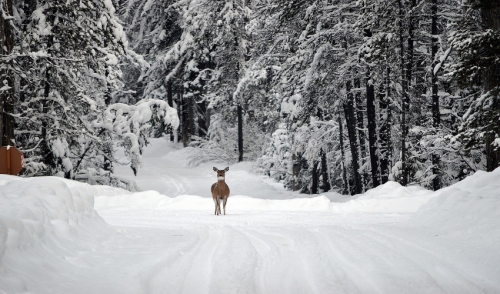
Winter nutrition is very important for deer and the individuals that hunt them. Even though hunting season is typically during the colder months, during these months deer are in an energy deficit. This means there is less food for them to eat and as a result they tend to lose weight or become smaller. If you are a hunter, the last thing you want your trophy buck to be is small and weak. Deer cannot meet energy intake requirements during the winter because of digestive and anatomical limitations.
White-tailed dear eat a variety of plant materials to sustain their physiological functions. Recent studies have revealed that there over 600 plant species in the diet of a whitetail. Although there is still much to be learned about the nutritional needs of deer, a deer’s nutritional requirement varies depending on sex, age, physiological state, and weather conditions. White-tailed deer nutrition will become varied and complex because of the countless variables that can influence not only the type of food available, but also the quality. For example, deer that live in habitats that contain large amounts of woodlands will have access to acorns if not covered by the snow, whereas deer that do not live in habitats that contain a lot of woodlands will have access to crops such as corn, soybeans, and wheat.
White-tailed deer are browsing animals, which means they will feed off a mix of forages, wood browse such as forbs and broad-leaved plants, masts, and grasses. A single food item does not make up the entirety of whitetails’ nutrition needs because the food selection is dependent on the foods palatability, availability, and the season. To fully support a healthy whitetail deer population, adequate amounts of diverse food must be made available throughout the year, especially during the winter, when energy needs are at their highest.
Winter nutrition for deer can be broken down into four categories: protein, energy, minerals, and water. Whitetails need protein for normal body maintenance, growth, reproduction, lactation, and antler growth. A high protein diet is high beneficial for male deer to produce big antlers that reflect their genetic potential. Protein requirements change throughout the year and vary depending upon age and sex of the individual deer. However, the need for protein during the winter is not as important as it is during the spring and summer. Deer also require energy for body maintenance, reproduction, and normal daily activities such as predator escape and body temperature regulation. White-tailed deer have high-energy requirements during the winter so that may keep warm, especially for fawns that require even more energy because they tend to have low body reserves. Studies have shown that during the winter, whitetails select foods that are rich in energy over foods that are high in protein. The energy provided by the foods not only help regulate body temperature, it also helps fight severe winter conditions. Minerals only make up about 5 percent of a deer’s body, however they are critical in supporting general metabolism and bone and antler growth. The two minerals that are the most essential to whitetails are calcium and phosphorus. Finally, whitetails need water every 24-48 hours to maintain health. Like for most animals water is a critical nutrient and these requirements are partially met by moisture within the vegetation they eat.
Winter can be a rough time for deer if they are not provided the right nutrition. Foods with high protein become less palatable and soft and hard mast foods and woody browse will become a primary source of nutrition in addition to agricultural crops and seasonal food plots. The bottom line is that to ensure a healthy white-tailed deer population, landowners need to understand not only how to provide nutrition for deer during the winter, but throughout the entire year with a diversity of forages full of protein, energy, and minerals.

Comments